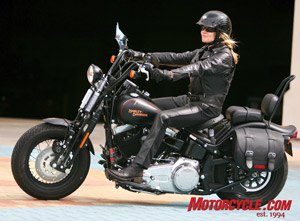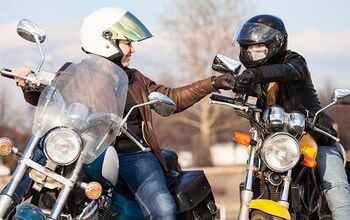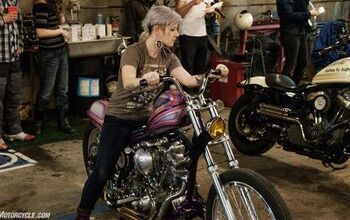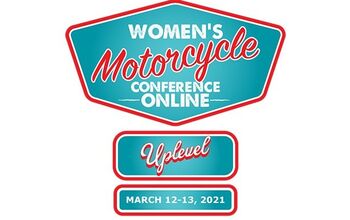Women in Motorcycling
It was just a normal family outing, except for one small difference. Dad brought a motorcycle. And so at age nine, Karen Davidson learned how to ride while on a family picnic.
“When most kids are moving up to a bigger bicycle, I graduated to an engine,” Davidson noted of her introduction to motorcycle riding.
But it wasn’t Davidson’s introduction to motorcycles. If you’re wondering, yes, Karen is one of those Davidsons (great-great granddaughter of company co-founder William A. Davidson) and the father who thought it was important to teach his children how to ride a motorcycle at a young age was none other than Willie G. himself. Davidson shared her experiences in St. Augustine, the last stop she and a group of fellow female riders would make before they rode into Bike Week 2008, where hundreds of other women riders would join them for a parade through the streets of Daytona Beach.
“The event was designed to celebrate women riders and to encourage existing riders to mentor others and help them get into the sport,” said Leslie Prevish, Harley-Davidson Women’s Outreach Manager. “Thousands of women are interested in riding but they don’t know how to start. We wanted to both educate and provide inspiration.”
“The company is building awareness of women riders,” said Davidson, “and the event is our way of embracing and acknowledging women motorcyclists.”
Women are a growing part of motorcycling, and what better place to see the impact of women on the industry than the nation’s largest motorcycle rally. According to the Motorcycle Industry Council, in 1990 4% of motorcycle owners were female. By the time of their latest survey in 2003, those numbers had grown to nearly 10% (current estimates put this percentage at 12).
But the increase of motorcycle ownership across the board makes the percentages a little misleading. Take a look at the hard numbers. Today over half a million women own motorcycles, another four million have licenses (numbers that increased nearly 40% from 1998 to 2003, during which time the number of overall motorcycle owners increased by only 16%). Today, the Motorcycle Safety Foundation estimates that roughly one-third of the students in their rider safety courses are female. It’s growth that the industry has taken notice of, being careful not to exclude the fastest growing segment of potential customers.
Harley points to their heritage with women riders. In a special part of the company's website dedicated to female riders, they show pictures of women on Harleys dating back to 1910 and list the exploits of famous Harley-mounted women, like Avis and Effie Hotchkiss (the first women to ride across the United States, in 1915) and Bessie Stringfield (the first African American woman to ride solo across the country). The company sees their current promotion of women riders as an extension of that heritage.
“It’s not something that we just started, but Harley has boosted its efforts to encourage women to ride,” Prevish said.
Harley’s efforts go beyond rallies. Besides offering lowered motorcycles, they have expanded their line-up of clothing and accessories to have greater appeal to women. Their dealerships have also started hosting “garage parties,” women-only events where female riders can learn more about motorcycles and get practical demonstrations, like how to pick up a downed bike. It’s also part of a campaign to educate the company’s dealership network on the needs of women bikers.
“We’re teaching our dealers things like not pushing a certain model as a ‘girl’s bike,’” Davidson said. “We’re working to give our dealerships the tools they need to get women riders on the bike that’s best for them.”
But Harley-Davidson isn’t the only manufacturer which is paying attention to the needs of female riders. BMW also touts its heritage with women motorcyclists.
“BMW has been in the forefront of showing women in the market, including real women owners and riders in the “Real Riders” ad campaign of a few years back,” said Laurence Kuykendall, BMW Community and Communications Manager.
New for 2008, BMW has announced adjustable seat heights or optional lower seats for all its models, as well as specific models with lowered suspension that makes the motorcycle one to two inches shorter, including full-sized bikes like the R1200GS and the R1200R and RT.
“Eighty percent of women ride cruisers because they are so ubiquitous and they have a lower seat height,” Kuykendall noted. “BMW traditionally has a smaller percentage of women riders than the industry because we don’t have the traditional entry-level motorcycle.”
The new models are part of an overall approach at BMW to introduce lighter and lower models, such as the F800S and a 30.3-inch optional seat on the R1200R that are aimed at entry-level riders and those of smaller stature.
“We’re not marketing these motorcycles specifically to women, but we’re marketing them to a group that women are a part of,” Kuykendall added. “It’s a marketing approach that’s not pandering or condescending. We don’t need to specifically target women to make models that women can benefit from.”
It’s not just the OEMs that are catching on to the market potential. Years ago, women had to be content with finding the man’s size that came closest to fitting their body. Now, from boots to helmets to gloves, women not only find female specific cuts and styles, but apparel and accessories that come in pinks and pastels. At Bike Week, the new style was everywhere as women exercised a freedom of choice that finally extended beyond black.
Besides owning and riding motorcycles, women have formed a presence within the industry that has gone beyond being umbrella girls or trade show booth babes. In front of the Kawasaki demo tent, a ride leader mounted a KLR650. Once in the saddle, she skillfully balanced the tall motorcycle on her tiptoes. Every day at Bike Week, Wendy Varner was breaking the stereotype of the girl on a small bike. Having ridden on the street since she was 15, Varner has owned a wide range of motorcycles, including a Goldwing, and rides everything in the demo fleet (which is basically everything that Kawasaki makes) from the ZX-14 to a KLR. Her presence at the Kawasaki tent tends to draw attention.
"Some people find it interesting that I’m a girl that rides bigger bikes," she noted.
Varner has worked with the Kawasaki demo fleet for eight years, which gives her an interesting perspective on women’s interest in motorcycles.
“The number of women taking demo rides has increased tremendously in the last two to three years,” she noted. “And they’re not limiting themselves to the smaller bikes. They’re riding everything.”
Further down the line at the BMW tent, Alisa Clickenger had a different introduction to the sport.
“One night I had a dream that I was riding a motorcycle and I loved the feeling I had in the dream,” she recalled.
Soon after, Clickenger bought a motorcycle, chucked her corporate career and made riding a major part her life. Touring is her main interest. She has crossed the country solo on her R1200GS and plans one day to tackle the Pan-American Highway. This year she joined BMW as an outrider in their demo fleet.
“Now I embrace motorcycle riding as part of who I am versus something that I do,” Clickenger said. “A woman traveling by herself on a motorcycle is, unfortunately, still an anomaly, but motorcycle riding is a gender-neutral activity. A lot of women say ‘I wish I could ride,’ but they never try it.”
As part of her job with BMW, Clickenger takes special interest in the women who seek her out for questions, steering them towards a bike in the demo fleet that will best fit the kind of riding they do and encouraging them to pursue their two-wheeled dreams.
But it’s not just on the street and in the showroom where women are making a riding impact. A few miles down the road from the International Speedway, in the moments before the flat-track race, a crowd that ranged from young girls to old men gathered around a tent that held two pink and glittery Honda race bikes and one small rider. Number 16x, Nichole Cheza, in her second season in the premier flat-track class, was hard at work, signing autographs. Like Clickenger and Davidson, Cheza hopes what she does is an encouragement and example to other women.
“In school, girls and guys are separated in sports at a young age,” Cheza said. “I want to be an inspiration to girls to go and do things like motorcycle racing.”
Cheza is in her fifth season of professional racing. She’s been riding since she was three years-old and racing nearly as long. A member of the flat-track “Michigan Mafia,” when the weather gets cold she’s ice racing. In 2003 she was named the AMA Female Athlete of the Year. In 2004, she broke her back racing but doggedly staged a comeback the following year. Nichole Cheza is only 20 years-old.
“I like the speed and I like the competition,” she said of motorcycle racing. “I grew up hanging out with the guys, so I like being ‘one of the guys’ and having all of the other racers know that I am just as serious as they are.”
Cheza’s plans include being the first women’s flat-track national champion and, like many dirt trackers, to move on to road racing someday. Back at the Speedway, several women were already paving the way for her.
On the banking, Canadian rider Misti Hurst was making history, qualifying high enough to become the first woman to race an AMA 600 Supersport final event at Daytona. Last year Hurst attended several AMA races, and this year she will try and complete the entire Supersport season.
“I started out as a passenger, but then I saw a woman riding and wanted a sportbike,” Hurst said of her introduction to motorcycles. “A year later I saw my first race and was hooked after the parade lap. On the track I’m not just ‘a girl,’ I’m a racer.”
Earlier in the week during the Moto-ST races, another female rider was hard at work, hoping to earn her way into the AMA series. Rachel Sasse was co-piloting a Buell XB9R in the GrandSport Twins class of the endurance racing event. Like many racers, Sasse started out riding on the street, wrecked and then moved to the race track. She’s worked her way up through ASRA and CCS events and into the up-and-coming Moto-ST series. It was her first time riding on the Daytona banks.
Women have come a long way, securing their presence on the street and on the track, in the showroom and in the pits.
"Some women like the attention, but I just want to be one of the guys," Sasse said of what it’s like to be a woman in the male-dominated sport. “I think there aren’t many women in the sport because to race you have to have the mindset of ‘I might die today,’ which most women don’t have.”
On Sasse’s small team, she also works as manager and an extra hand when it’s time to wrench, learning the ins and outs of engine internals and suspension set-up as she goes. Her involvement with motorcycles extends off the track as well. She is the co-owner of the newly opened RNR Cycles, a motorcycle repair and race shop in Virginia. But while her opportunities in the industry expand, her focus is on racing.
“I hope to get faster and take my racing to the next level,” she said. “I don’t want to just be ‘fast for a girl.’ I want to be winning races against guys.”
The presence of women riders at Daytona Bike Week varied from the subtle, the fleeting glimpse of a pony tail flying behind a helmeted head on the race track, to the unmistakable, the roar of the engines of hundreds of Harley-mounted women riders announcing their presence in a parade down the streets of Daytona. Women have come a long way, securing their presence on the street and on the track, in the showroom and in the pits. But they have a long way to go before they make up the 50% of motorcycle riders that they should constitute. But now that they’ve moved up to the handlebars and are in on how much fun it is to ride motorcycles, they’re here to stay.
Related Reading
Femmoto 2007
WIMA International Rally- Sweden Ride Report
K&N Del Mar Mile Weekend -Travel back in time and see Cheza's early days of flattrack in this story.
More by Jeremiah Knupp





































Comments
Join the conversation